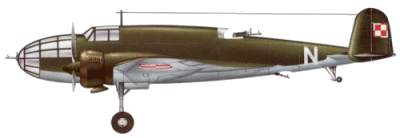
At the outbreak of
World War II the P.Z.L. P.37 Lot (elk) was not only one of the most
advanced bombers produced by the Polish aircraft industry to that date,
but was also the only aircraft in service with the Polish air force
that could be regarded as being of modern design. P.Z.L. had proposed
the P.Z.L.3 advanced bomber to meet a Department of Aeronautics
requirement for an aircraft in this class, but the financial
stringencies of 1930 prevented the PZ.L.3's progress beyond the design
stage. P.Z.L.'s next proposal was for a bomber version of the P.Z.L.30
civil transport which, having failed to attract a buyer, was converted
as a bomber prototype by P.Z.L. It was later developed and put into
production by the L.W.S. company as the L.W.S.4 Zubr. P.Z.L, then
produced the design for a twin-engine bomber of monoplane
configuration, gaining a contract for three prototypes in 1935. The
first of them, the P.Z.L. P.31/I, was flown initially in late June
1936.

Successful testing of
this aircraft, which was powered by two 873 hp (651 kW) Bristol Pegasus
XII radial engines, led to a contract for 30 under the designation
P.37A Los A. Production was completed in 1938, the first 10 having a
single fin and rudder, but the last 20 sporting the twin fins and
rudders which had been introduced and tested on the P.37/II prototype.
This latter prototype had also been used for development testing of
engines in the 1,000 hp (746 kW) class by manufacturers that included
Fiat, Gnome-Rhôene and Renault. Demonstrated at an exhibition in
Belgrade during 1938 and at the Paris Salon in the same year, the P.37A
created enormous interest, resulting in export orders for a total of 35
P.37C bombers powered by 970 hp (723 kW) Gnome-Rhône 14N.07 engines for
Bulgaria (15) and Yugoslavia (20), and 40 P.37D bombers with 1,050 hp
(783 kW) Gnome-Rhône 14N.20/21 engines for Romania (30) and Turkey
(10). In addition, Turkey ordered components for 15 more aircraft and
signed a licence to manufacture. Planned delivery for these export
aircraft was from June 1940 and as a result, none of them was
completed. The delivery of Los A aircraft to the Polish air force began
in early 1938, and all of these were equipped subsequently with dual
controls for use as conversion trainers.

Delivery of the ensuing
P.37B Los B (which introduced a revised cockpit canopy, twin-wheel main
landing gear units and Pegasus XX engines) began in late 1938. A total
of 150 had been ordered, but policy changes that favoured fighters
rather than bombers reduced the number to 100, and only about 70 of
these had been delivered by the outbreak of war. Even more disastrous
for Poland was the fact that of the Los B aircraft in service only 36
were fully equipped for operational use, though these were supplemented
quickly by nine more replacement aircraft. Some 26 of this number were
lost in action, and on 17 September 1939 the survivors, plus about 20
other P.37s, were flown to Romania, where they were used subsequently
by the Romanian air force. A developed version of the P.37 had been
planned under the designation P.49 Mis (teddy bear), intended to be
powered by engines of up to 1,600 hp (1193 kW). A prototype was under
construction, but with the German advance on Warsaw it was destroyed to
prevent it from falling into enemy hands.
Variants
PZL P.37A Los A - The
first prototype, the P.Z.L. P.31/I, was flown initially in late June
1936 and successful testing of this aircraft, which was powered by two
873 hp (651 kW) Bristol Pegasus XII radial engines, led to a contract
for 30 under the designation P.37A Los A.
PZL P.37C - A total of
35 P.37C bombers powered by 970 hp (723 kW) Gnome-Rhône 14N.07 engines
intended for Bulgaria (15) and Yugoslavia (20), but never completed.
PZL P.37D - A total of 40 P.37D bombers with 1,050 hp (783 kW) Gnome-Rhône
14N.20/21 engines intended for Romania (30) and Turkey (10), but never
completed.
PZL P.37B Los B - An
improved version which introduced a revised cockpit canopy, twin-wheel
main landing gear units and Pegasus XX engines. Deliveries began in
late 1938 with only 70 aircraft being produced out of the 100 ordered.
PZL P.49 Mis (teddy
bear) - A version of the P.37 had been planned under the designation
P.49 Mis (teddy bear), intended to be powered by engines of up to 1,600
hp (1193 kW). A prototype was under construction at the time of the
German invasion, but it was destroyed rather than have it fall into
German hands.
Specifications (PZL
P.37B Los B)
Type: Four Seat
Medium Bomber
Design:
Panstwowe Zaklady Lotnicze Design Team led by Jerzy Drabrowski
Manufacturer:
Panstwowe Zaklady Lotnicze in Poland
Powerplant: Two
925 hp (690 kW) P.Z.L. built Bristol Pegasus SS radial engines.
Performance:
Maximum speed 277 mph (445 km/h) at 11,155 ft (3400 m); service ceiling
30,000 ft (9145 m) without bombload.
Range: 932 miles
(1500 km) on internal fuel with 4,850 lbs (2200 kg) bombload.
Weight: Empty
9,436 lbs (4280 kg) with a maximum take-off weight of 19,621 lbs (8900
kg).
Dimensions: Span
58 ft 10 3/4 in (17.95 m); length 42 ft 4 3/4 in (12.92 m); height 16
ft 8 1/4 in (5.09 m); wing area 575.89 sq ft (53.50 sq m).
Armament: Three
7.7 mm (0.303 in) KM Wz. 37 machine guns in nose, dorsal and ventral
positions, plus a bombload of up to 5,688 lbs (2580 kg) carried
internally.
Variants: P.37A
Los A, P.37C (Bulgaria & Yugoslavia but never completed), P.37D
(Romania & Turkey but never completed), P.37B Los B, P.49 Mis.
Avionics: None.
History: First
flight (prototype) June 1936; production completed (P.37A Los A) 1938.
Operators:
Poland. |
